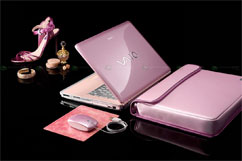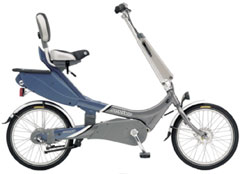 |
By Richard Seireeni |
|
|
|
by Richard Seireeni, Brand Architect May 18, 2007 |
||||
Tom Peters, the brand commentator, shared some interesting statistics at a design conference in San Francisco a few years back. According to his sources, spending by US males equaled the entire gross national product of Germany, which was about 3.8 trillion dollars at the time. Germany is the world's third largest economy. Surprisingly, spending by US females was nearly 4.3 trillion dollars, or equivalent to the GNP of Japan, the world's second largest economy. That's a lot of buying power! Additional voices have added to this startling fact. "Women buy or influence over 83% of consumer purchases," according to InWomenWeTrust.com. J.D. Power and Associates reported that "women now purchase more than half of all cars sold in the United States and significantly influence 80 percent of all auto purchases." And, as "Diane MacEachern argues in Big Green Purse, the best way to fight the industries that pollute the planet, thereby changing the marketplace forever, is to mobilize the most powerful consumer force in the world — women." The point is that women's spending has out distanced men's spending for a number of reasons. First, women have always dominated in the purchase of consumable items like groceries, cleaning products, health care products, etc. As more and more of these products have come into the market, the relative spending on consumables verses durable goods has increased. For example, twenty years ago women bought cloth dishtowels and reused them often. Today, women buy disposable paper towels and buy them often. This trend toward increased consumable sales verses durable sales is evident in many industries. As women continue to make most buying decisions on consumables, their buying power and their subsequent influence over how those products are made has grown. As a result, women who are interested in environmental health can profoundly influence the development of more and better eco-friendly consumable products. The second reason women's consumption has increased is because women are increasingly making decisions about things like cars, insurance, mortgages, travel, etc. These are buying choices that were traditionally a decision area for men. However, in contemporary married settings, women are making more decisions about things like the family car, health care, and where the family will spend the summer vacation in addition to traditional decision making areas like furniture and appliance selection. Working wives and mothers, who have steadily increased in numbers over their non-working counterparts, are making spending decisions with their own income about such things as retirement and savings. These women are also getting organized. Add to this the fact that unmarried women, who are free to make decisions on all their spending needs, are getting married at an increasingly later age, which means they are spending as they choose for longer periods of their lives. There are many information and support groups for working women, single Mom's, executive women, etc. The EcoMomAlliance.org out of the Bay Area is one of the more influential of these social networking sites and guides mothers toward sustainable consumer choices. So, how are companies responding to the increased spending of women? The answer is, not very well and not all that quickly. At least not in the West. Gender Branding: How Consumer Good Makers Are Responding To Female Spending Power in Japan. On my most recent trip to Japan, I was once again reminded at how well this otherwise traditional, male-centric society markets to women. Virtually every product category has brands that are specifically built or modified to appeal to women. And it isn't just a facelift. They are not simply putting a pretty face on a previously neutral or male oriented product. The Japanese are engineering gender into virtually every product category — giving traditionally neutral or male oriented brands a female point-of-view. Most remarkable among these efforts was the launch of a brand called WILL back in 2001. WILL is a brand that was created around a target audience, instead of around a specific product. Hakuhodo, the Japanese advertising giant, noticed that young, urban Japanese women were putting off early marriage and playing an increasingly independent role in consumer spending. WILL was designed to reach these customers with a suite of products that addressed their lifestyle needs and spending patterns. Initially, seven manufacturing partners were identified to produce the WILL family of products that included a car by Toyota, a computer by Panasonic, a beer by Asahi, kitchen appliances from National, cosmetics, travel services, etc. All the products were designed to appeal to women. All carried the brand name WILL. The showrooms, which are dominated by the car product, were designed like a women's clothing boutique and have been placed in shopping areas that women frequent. The sales staff is entirely female, which is a first in the automotive retail category in Japan, or in any country for that matter. In truth, WILL has been only a moderate financial success, but the precedent it established in the world of marketing has not gone unnoticed by the Western press. What has gone unnoticed is that the Japanese have been building gender-based brands for industries that have traditionally produced male oriented products for a number of years now. Many of these efforts have been very successful. NTT's Do-Co-Mo group was the first Telecommunications Company to realize that women like to talk on their cell phones more than men do. So it was Do-Co-Mo, not Nokia, not Erickson, and not Motorola, that pioneered the compact, sleek cell phones that are perfect for a woman's hand and a woman's purse. Do-Co-Mo also pioneered the first of the cell-to-cell discount programs whereby users could talk with their network of mobile phone friends at reduced rates. While not exclusively for women, this program was particularly appealing to female Do-Co-Mo customers. Do-Co-Mo also pioneered certain early web and email services accessed by mini-computers designed to look like cosmetic packages. These Palm-like devices predated similar products in the U.S. and were wireless as early as 1998 when connected to a Do-Co-Mo mobile phone. The West has recently caught up with phones by Nokia, Erickson and Motorola that have a gender-neutral or slightly feminine vibe. Unlike Japan, they still do not offer specific products for women except for the occasional pink color option. So while the West dabbles with female designed products, the competition for women customers in the Japanese telecommunications market has been heating up, rather than cooling down. In a much publicized campaign by Japan's KDDI Group, a new web-enabled phone called Tu-Ka was launched. The phone and the web product that can be accessed are specifically tailored for women. The campaign spokesperson, Ayumi Hamasaki Sekai, is Japan's equivalent of Madonna. Do-Co-Mo has come back hard with co-branded wireless products that appeal to women. One of the newest of these is a Palm-like device, called Sigmarion, whose stainless shell was designed by Zero Halliburton. Another is a woman's compact look-a-like that houses a personal data and email device. Because of the popularity of these compact devices, similar versions are being made for men — but with male styling and a male brand position. Japan's computer and camera industries have also responded to gender in the creation of products with a decidedly feminine bias. Sony's VAIO line of computers was designed for stylishness and lightweight, qualities that recognize women's preferences, but attract men as well. In fairness, both the PalmV and the iMac have similarly given a nod to female tastes, but not with the conviction done in Japan. Nikon, Sony, Olympus, and the other big Japanese camera manufacturers have also engaged in fierce competition to win over female customers who make up a greater proportion of photographers than men, as measured by purchases of film and prints. The small, sleek devices manufactured by these previously male oriented manufacturers are designed to compliment clothing, like the more traditional accessories of belts, bags and jewelry. In fact, Japanese refer to these items as 'Techno-Jewelry'. And the trend does not stop with consumer products. There's a new mall in Tokyo called Venus Forte that caters exclusively to women by leasing space to women's retail shops only. Travel packages and even special resort complexes are now offered with single women as the target audience. Japanese software and game manufacturers regularly release male and female versions of their products; and, internet providers that have heretofore been gender neutral are now offering ISP packages with personal homepages and search engines configured for female users. Even insurance companies are getting in the act as they have begun to realize that men and women shop for insurance for different reasons. While men have been more concerned about leaving an endowment to their family after death, women are more concerned with how they and their children will be cared for if she becomes seriously ill. Women realize that they will live longer, and Japanese insurance companies are responding with packages that include childcare and even husband care in their offerings. This is a far cry from the attempts at gender branding we see at most American and European companies. While these organizations spend millions to "market" to women, they do not address gender in core issues such as brand — with the exception of some notable examples like recent attempts to launch women's banking institutions in the States and certain products like Virginia Slims. However, these are the exceptions rather than the rule. It's as though a decision is made that a product is either for women only, in which case it is branded feminine, or it is for men only or for men and women, in which case the brand is automatically masculine. Things like cars, computers, insurance, and travel all have a masculine bias and ignore women's preferences at their peril. For instance, the eco-friendly electiric car would seem to have an immediate audience with women, especially women who stay home to care for their families. They tend to drive shorter distances, which are perfect for the electric car range. So, why aren't these cars marketed directly to women like the WILL car is in Japan? Of course, some change is in the wind. Toyota's Scion line, originally designed for younger customers, has been an indirect hit with Mom's. Nike has recently launched female versions of their Niketown complexes, called Goddess, that spin the sports and fitness message to women. But by in large, little female branding goes into products outside traditional female products like cosmetics, clothing and home furnishings. In Japan, brands are deployed in a number of guises. Most are still masculine, but enlightened companies are addressing gender issues by producing both a male and female vision of the brand. For instance, some pioneering Japanese websites will ask the sex of the visitor and then send women down a different track than men. The entire brand experience is fundamentally different for each sex. And this leads to a subtle issue. Brands that would consider a gender bias must recognize that men and women have different needs, and neither want to be pandered to. Building a female gender into a brand, for instance, demands that companies recognize that a lot has happened since the Suffragettes marched on Washington. Women have money and therefore power. They want products and services that truly meet their needs, as opposed to some male notion of what is appealing to women. As one female executive was heard to say, "I have money, but no one knows how to get me to spend it." For brand managers and brand consultancies, the message is to get women into the upper ranks of decision-making where brands are forged. This ultimately leads back to the importance of adopting earth-friendly business practices and making cradle-to-cradle products that reduce depletion of natural resources. Women, with their traditional nurturing role, have become vocal supporters of sustainability. They have enormous buying power. Business leaders would be wise to connect the dots and respond to this particularly feminine call for action.
Updated from an essay written in 2001. © Rick Seireeni, Brand Architect and President The Brand Architect Group is a strategic brand consultancy with offices in Los Angeles, Tokyo and Shanghai. Project specialties include retail, food service, banking and real estate development.
|
Examples of how Japanese consumer good manufacturers are designing for women. From top: The Will city-car from Toyota marked the first time a car was designed and marketed specifically for women; the Sony VAIO, originally designed as a light weight laptop for women; Panasonic's D-Snap, one of dozens of 'Techno-Jewelry' phone and camera devices; and Sony's portable AirBoard internet connectivity device.
The Giant Revive Spirit semi-recumbent electric bicycle was designed for female anatomy. Articles by Richard Seireeni: |
![]()





